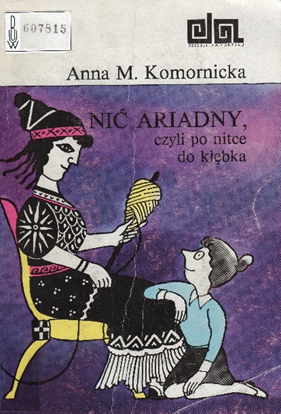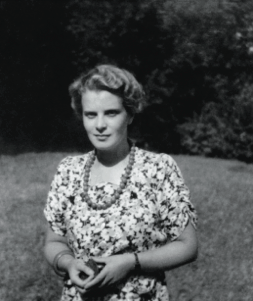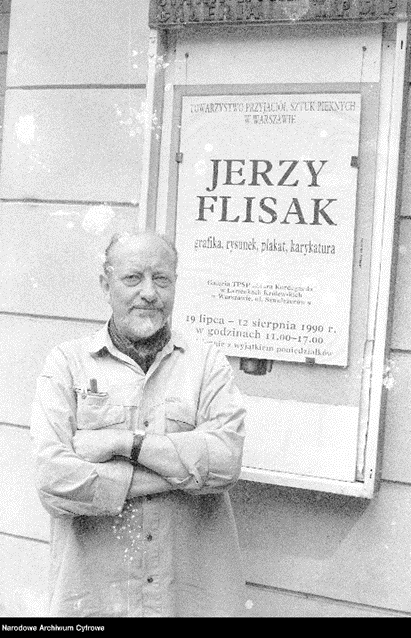Title of the work
Country of the First Edition
Country/countries of popularity
Original Language
First Edition Date
First Edition Details
Anna M. Komornicka, Nić Ariadny, czyli po nitce do kłębka, "Dziedzictwo antyku". Warszawa: Wydawnictwa Radia i Telewizji, 1989, 164 pp.
ISBN
Genre
Glossary
Myths
Short stories
Target Audience
Children
Cover

Courtesy of the publisher
Author of the Entry:
Summary: Olga Grabarek, University of Warsaw, olga.grabarek@student.uw.edu.pl
Analysis: Marta Pszczolińska, University of Warsaw, m.pszczolinska@al.uw.edu.pl
Peer-reviewer of the Entry:
Katarzyna Marciniak, University of Warsaw, kamar@al.uw.edu.pl
Elżbieta Olechowska, University of Warsaw, elzbieta.olechowska@gmail.com
Jerzy Flisak
, 1930 - 2008
(Illustrator)
Jerzy Flisak was a Polish graphic artist, illustrator, and scenographer, well-known for his drawings and posters. He graduated from the Warsaw University of Technology [Politechnika Warszawska] with a diploma in architecture. His drawings were published in various weeklies, including Szpilki [Scores], where he was the graphic editor, Polityka [Politics], Świat [The World], Przegląd Kulturalny [The Cultural Review], and periodicals aimed at children, such as Świerszczyk [The Little Cricket] and Płomyczek [The Little Flame]. For Świerszczyk he created a popular comic column Co robi nasz Bobik [What’s Up with Our Bobik] about an amusing dog that children liked the most (see here and here, accessed: April 7, 2022). Jerzy Flisak was also the author of illustrations for many children’s books creating his own style. He worked as well for Short Film Forms Studio Se-Ma-For in Łódź and Animated Cartoons Studio SFR in Bielsko-Biała.
Source:
Culture.pl (accessed: April 7, 2022).
Poster.pl (accessed: April 7, 2022).
Bio prepared by Marta Pszczolińska, University of Warsaw, m.pszczolinska@al.uw.edu.pl

Photograph courtesy of the Author.
Anna M. Komornicka
, 1920 - 2018
(Author)
Classical philologist, specialized in Greek comedy and archaic lyric poetry; her research covered also texts of the Greek Fathers, reception of the Bible, genesis and evolution of concepts in ancient literature; translator of Greek and Roman, as well as contemporary literature into Polish; Editor-in-Chief of the classical journal “Meander”; author of books and radio-plays inspired by Antiquity for children and adolescents. Honorary Member of the Scientific Committee on Ancient Culture of the Polish Academy of Sciences (KNoKA PAN).
Sources:
Jadwiga Czerwińska, “Profesor Anna Maria Komornicka, nasz mistrz”, Meander 63 (2008): 4–14 (accessed: June 11, 2021).
Anna M. Komornicka, “Anna M. Komornicka: Listy do Meandra”, Meander 74 (2019): 179–201 (accessed: March 29, 2021).
Jan Komornicki, “Pożegnanie Cioci Anny z Wolańskich Komornickiej (27 września 1920 – 17 grudnia 2018)”, Meander 74 (2019): 3–8 (accessed: June 11, 2021).
Bio prepared by Elżbieta Olechowska, University of Warsaw, elzbieta.olechowska@gmail.com
Sequels, Prequels and Spin-offs
Anna M. Komornicka. Historie nie z tej ziemi, Warszawa: Wydawnictwa Radia i Telewizji, 1987, 165 pp.
Anna M. Komornicka, Alfa i Omega, czyli starożytność w miniaturze, Warszawa: Oficyna Wydawnicza Ostoja, 1995, 175 pp.
Summary
Based on: Katarzyna Marciniak, Elżbieta Olechowska, Joanna Kłos, Michał Kucharski (eds.), Polish Literature for Children & Young Adults Inspired by Classical Antiquity: A Catalogue, Faculty of “Artes Liberales”, Warsaw: University of Warsaw, 2013, 444 pp.
This is the second volume in the series The Legacy of Antiquity, based on radio programs and plays for children, where the author explains phrases, sayings, and expressions originating from Greek myths, such as “the sufferings of Tantalus”, “an apple of discord”, “the Trojan Horse”, etc. The author applies a pattern: first, a discussion of the myth at the origin of the term or phrase, then a reflection on each entry’s meaning and modern usage in a dramatized scene with children as characters.
Analysis
After the success of Historie nie z tej ziemi, where seven mythical plots interwoven with contemporary stories were introduced to children, this volume focuses on the phrases that originated in myths. The book was inspired by a letter, which the author recounts in the Introduction. When the author was writing programs about antiquity for Polish Radio, a girl wrote her a letter asking questions about the expression “Achilles’s heel”, explaining that she could not find where it came from. The letter made the author realise that there was a need for a publication aimed at children that explains the origins of phrases or expressions concerning classical antiquity and their current meaning. At the time of the book’s first edition, there was no Internet and only a limited access to lexicons and encyclopaedias. In this context, the letter from the medium-size south-eastern city of Nowy Sącz reflected the real needs of children. Anna Komornicka – a professor of classics and full-time mother – wrote a book that met young readers’ expectations, explained in contemporary language phrases rooted in Greek and Roman myths and/or history, and provided amusing stories about children, relatable and easy to understand. This device allowed the author to pursue her didactic goal: children were having fun learning about the origins and use of words by witnessing short scenes set at school or home.
The book is divided into almost 50 concise chapters. Each has its leitmotiv – a word, an idea, a sentence or a quotation originating in ancient myths. The “mythical” part features storytelling well adapted to children; key issues of the myth are explained without the use of archaic language. The second part of each chapter usually presents a short scene with children as protagonists set in the contemporary world, usually at school or at home. However, some of the stories have a detective nature. The storytelling follows the Socratic method – the described short scene leads to a conclusion that is not explicitly stated but is readily apparent. Adding to the book’s educational value, the author also cites modern and ancient authors, including Homer, Plutarch, Ovid, Hyginus, and others.
A characteristic feature of Komornicka’s writing style is alternating between funny, serious and reflective themes. For example, topics based on authentic events, in Beczka Danaid [The Barrel of the Danaïdes], an older man tells his grandchildren about his harrowing experiences in a concentration camp during WW2; Wierna Penelopa [Faithful Penelope] features a war widow and a letter from her late husband, a prisoner of KL Sachsenhausen; Odyseja [The Odyssey] presents the post-war fate of another Polish soldier, and Parki – Mojry przędą nić ludzkiego życia [Parcae – Moirai Weave the Thread of Mortal Life] shows school children on a field trip through the Powązki Cemetery in Warsaw, where they learn about Polish patriotic history.
Further Reading
Czerwińska, Jadwiga, “Profesor Anna Maria Komornicka, nasz mistrz”, Meander 63 (2008): 4–14 (accessed: April 8, 2022).
Czerwińska, Jadwiga, “Z Grzymałowa w świat antyku”, Cracovia Leopolis 43 (2005): 2–5, 51 (accessed: April 8, 2022).
Komornicka, Anna M., “Anna M. Komornicka: Listy do Meandra”, Meander 74 (2019): 179–201 (accessed: April 8, 2022).
Komornicki, Jan, “Pożegnanie Cioci Anny z Wolańskich Komornickiej (27 września 1920 – 17 grudnia 2018)”, Meander 74 (2019): 3–8 (accessed: April 8, 2022).
Marciniak, Katarzyna, “(De)constructing Arcadia: The Polish Struggles with History and Differing Colours of Childhood in the Mirror of Classical Mythology”, in Lisa Maurice, ed., The Reception of Ancient Greece and Rome in Children’s Literature: Heroes and Eagles, Boston and Leiden: Brill, 2015, 56–82.



